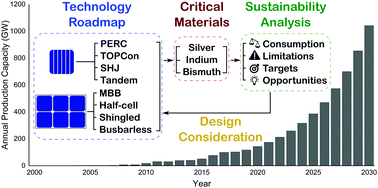Design considerations for multi-terawatt scale manufacturing of existing and future photovoltaic technologies: challenges and opportunities related to silver, indium and bismuth consumption
Abstract
To significantly impact climate change, the annual photovoltaic (PV) module production rate must dramatically increase from ∼135 gigawatts (GW) in 2020 to ∼3 terawatts (TW) around 2030. A key knowledge gap is the sustainable manufacturing capacity of existing and future commercial PV cell technologies imposed by scarce metals, and a suitable pathway towards sustainable manufacturing at the multi-TW scale. Assuming an upper material consumption limit as 20% of 2019 global supply, we show that the present industrial implementations of passivated emitter and rear cell (PERC), tunnel oxide passivated contact (TOPCon), and silicon heterojunction (SHJ) cells have sustainable manufacturing capacities of 377 GW (silver-limited), 227 GW (silver-limited) GW and 37 GW (indium-limited), respectively. We propose material consumption targets of 2 mg W−1, 0.38 mg W−1, and 1.8 mg W−1 for silver, indium, and bismuth, respectively, indicating significant material consumption reductions are required to meet the target production rate for sustainable multi-TW scale manufacturing in about ten years from now. The industry needs urgent innovation on screen printing technologies for PERC, TOPCon, and SHJ solar cells to reduce silver consumption beyond expectation in the Industrial Technology Roadmap for PV (ITPRV), or the widespread adoption of existing and proven copper plating technologies. Indium cannot be used in any significant manufacturing capacity for PV production, even for futuristic 30%-efficient tandem devices. The current implementation of low-temperature interconnection schemes using bismuth-based solders will be limited to 330 GW of production. With half the silver-limited sustainable manufacturing capacity as PERC, the limited efficiency gains of SHJ and TOPCon cell technologies do not justify a transition away from industrial PERC, or the introduction of indium- and bismuth limitations for SHJ solar cells. On the other hand, futuristic two-terminal tandems with efficiency potentials over 30% have a unique opportunity to reduce material consumption through substantially reduced series resistance losses.



 Please wait while we load your content...
Please wait while we load your content...